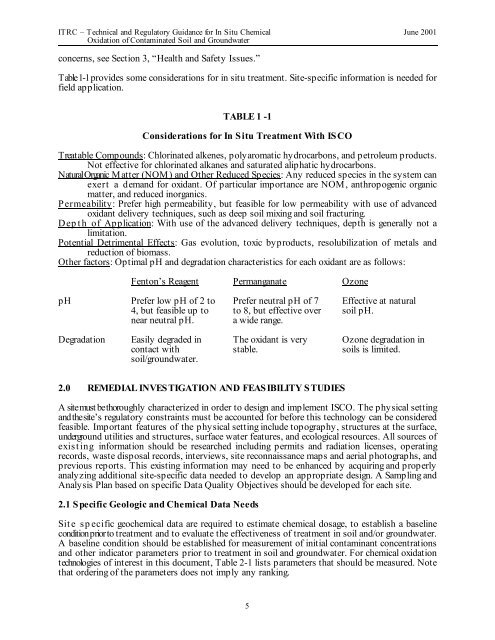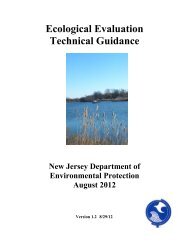Technical and Regulatory Guidance for In Situ Chemical ... - ITRC
Technical and Regulatory Guidance for In Situ Chemical ... - ITRC
Technical and Regulatory Guidance for In Situ Chemical ... - ITRC
Create successful ePaper yourself
Turn your PDF publications into a flip-book with our unique Google optimized e-Paper software.
<strong>ITRC</strong> – <strong>Technical</strong> <strong>and</strong> <strong>Regulatory</strong> <strong>Guidance</strong> <strong>for</strong> <strong>In</strong> <strong>Situ</strong> <strong>Chemical</strong> June 2001<br />
Oxidation of Contaminated Soil <strong>and</strong> Groundwater<br />
concerns, see Section 3, “Health <strong>and</strong> Safety Issues.”<br />
Table 1-1 provides some considerations <strong>for</strong> in situ treatment. Site-specific in<strong>for</strong>mation is needed <strong>for</strong><br />
field application.<br />
TABLE 1 -1<br />
Considerations <strong>for</strong> <strong>In</strong> <strong>Situ</strong> Treatment With ISCO<br />
Treatable Compounds: Chlorinated alkenes, polyaromatic hydrocarbons, <strong>and</strong> petroleum products.<br />
Not effective <strong>for</strong> chlorinated alkanes <strong>and</strong> saturated aliphatic hydrocarbons.<br />
Natural Organic Matter (NOM) <strong>and</strong> Other Reduced Species: Any reduced species in the system can<br />
exert a dem<strong>and</strong> <strong>for</strong> oxidant. Of particular importance are NOM, anthropogenic organic<br />
matter, <strong>and</strong> reduced inorganics.<br />
Permeability: Prefer high permeability, but feasible <strong>for</strong> low permeability with use of advanced<br />
oxidant delivery techniques, such as deep soil mixing <strong>and</strong> soil fracturing.<br />
Depth of Application: With use of the advanced delivery techniques, depth is generally not a<br />
limitation.<br />
Potential Detrimental Effects: Gas evolution, toxic byproducts, resolubilization of metals <strong>and</strong><br />
reduction of biomass.<br />
Other factors: Optimal pH <strong>and</strong> degradation characteristics <strong>for</strong> each oxidant are as follows:<br />
Fenton’s Reagent Permanganate Ozone<br />
pH Prefer low pH of 2 to Prefer neutral pH of 7 Effective at natural<br />
4, but feasible up to to 8, but effective over soil pH.<br />
near neutral pH. a wide range.<br />
Degradation Easily degraded in The oxidant is very Ozone degradation in<br />
contact with stable. soils is limited.<br />
soil/groundwater.<br />
2.0 REMEDIAL INVES TIGATION AND FEAS IBILITY S TUDIES<br />
A site must be thoroughly characterized in order to design <strong>and</strong> implement ISCO. The physical setting<br />
<strong>and</strong> the site’s regulatory constraints must be accounted <strong>for</strong> be<strong>for</strong>e this technology can be considered<br />
feasible. Important features of the physical setting include topography, structures at the surface,<br />
underground utilities <strong>and</strong> structures, surface water features, <strong>and</strong> ecological resources. All sources of<br />
exist ing in<strong>for</strong>mation should be researched including permits <strong>and</strong> radiation licenses, operating<br />
records, waste disposal records, interviews, site reconnaissance maps <strong>and</strong> aerial photographs, <strong>and</strong><br />
previous reports. This existing in<strong>for</strong>mation may need to be enhanced by acquiring <strong>and</strong> properly<br />
analyzing additional site-specific data needed to develop an appropriate design. A Sampling <strong>and</strong><br />
Analysis Plan based on specific Data Quality Objectives should be developed <strong>for</strong> each site.<br />
2.1 Specific Geologic <strong>and</strong> <strong>Chemical</strong> Data Needs<br />
Sit e sp ecific geochemical data are required to estimate chemical dosage, to establish a baseline<br />
condition prior to treatment <strong>and</strong> to evaluate the effectiveness of treatment in soil <strong>and</strong>/or groundwater.<br />
A baseline condition should be established <strong>for</strong> measurement of initial contaminant concentrations<br />
<strong>and</strong> other indicator parameters prior to treatment in soil <strong>and</strong> groundwater. For chemical oxidation<br />
technologies of interest in this document, Table 2-1 lists parameters that should be measured. Note<br />
that ordering of the parameters does not imply any ranking.<br />
5
















